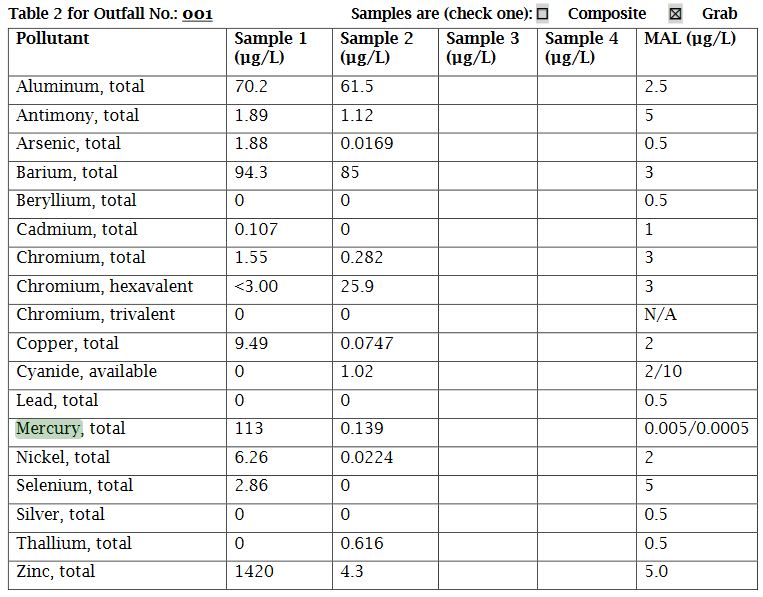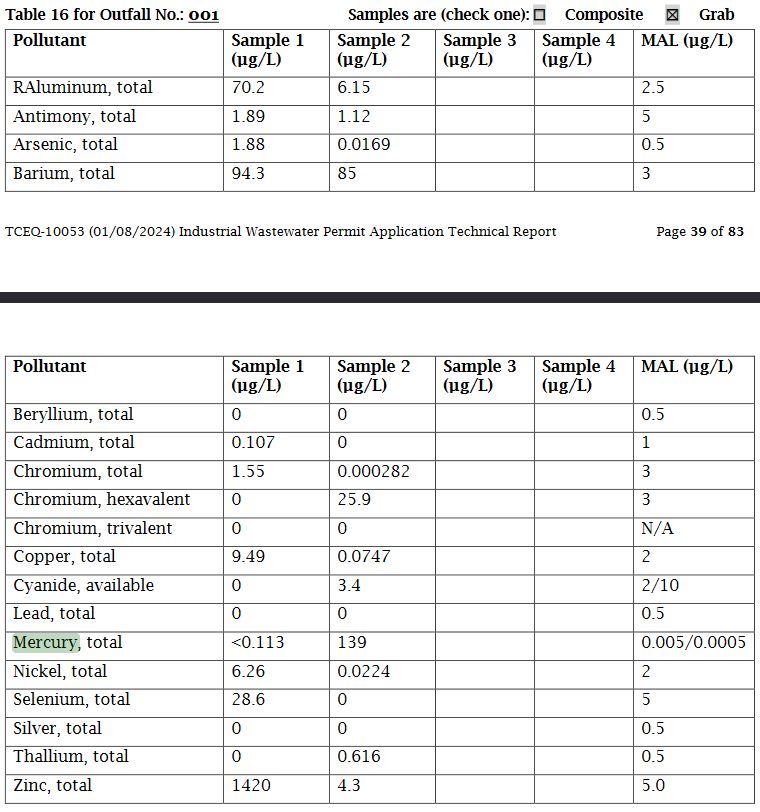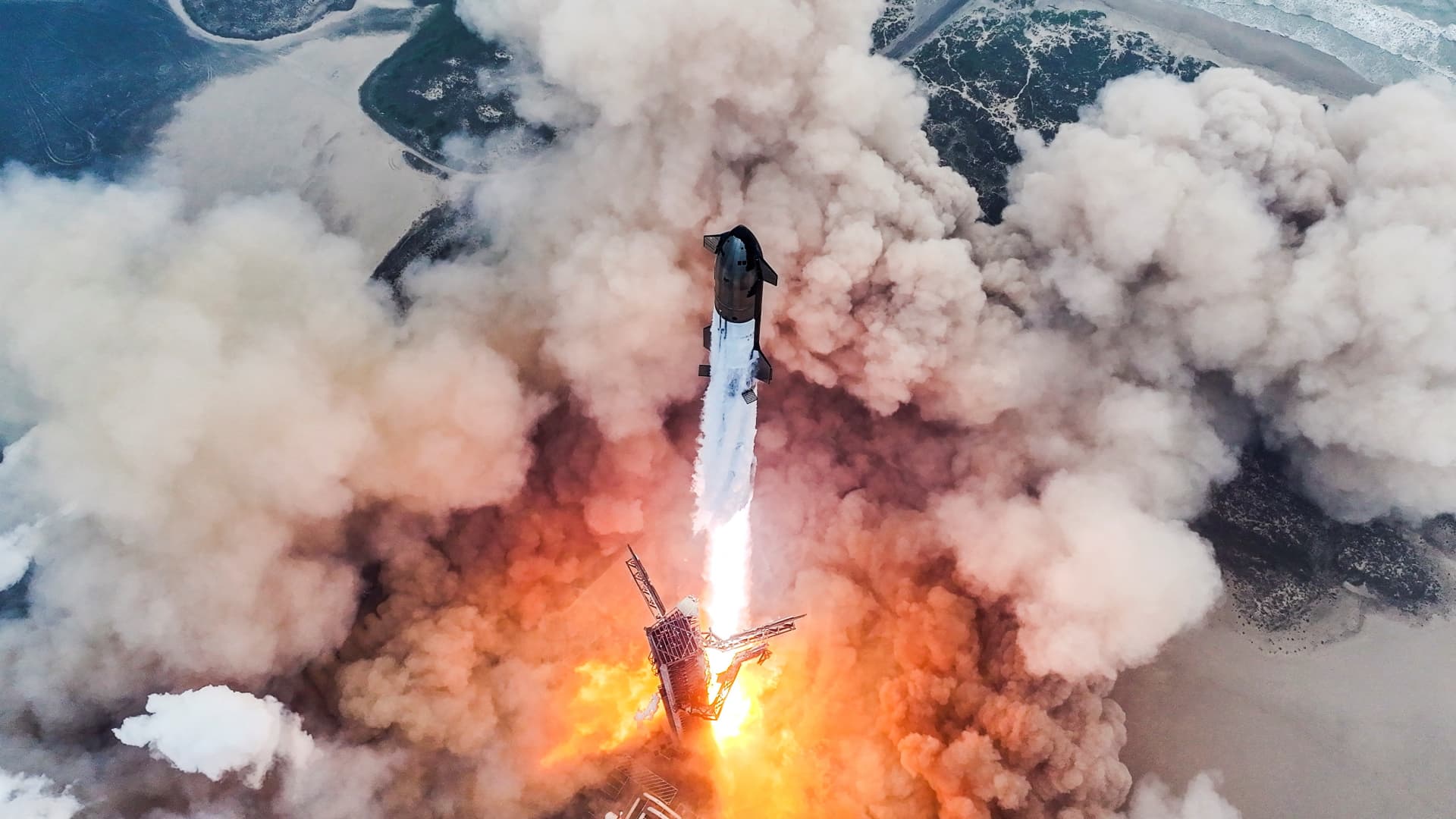Needs confirmation
Teague said he’s especially concerned about the concentration of mercury in the wastewater from the SpaceX water deluge system. The levels disclosed in the document represent “very large exceedances of the mercury water quality criteria,” Teague said.
I’m confused as to how the mercury got in the water in the first place. Is it leeching out of the storage tanks, or was it already present in the water prior to its delivery to SpaceX?
As far as I am aware, no part of the launch system relies on mercury as a major (or even minor) component. Where is the mercury coming from?
Looks like it might have literally been a typo. The figures in the report keep varying between xxx and 0.xxx: https://www.tceq.texas.gov/downloads/permitting/wastewater/title-iv/tpdes/wq0005462000-spaceexplorationtechnologiescorp-starbaselaunchpadsite-cameron-tpdes-adminpackage.pdf
Looks like it might have literally been a typo.
Interesting, looks like you might be right:


The mercury value for Sample 1 switches between 0.113 μg/L and 113 μg/L, and the value for Sample 2 switches between 0.139 μg/L and 139 μg/L. I also notice that the values for Aluminum (or “RAluminum”) switch between 61.5 and 6.15, and Chromium values switch between 0.282 and 0.000282. Seems rather sloppy. My analytical chemistry professor would not be impressed.
Additionally, SpaceX have since refuted the original CNBC article claiming it is “factually inaccurate”: https://x.com/SpaceX/status/1823080774012481862
Expand for long tweet:
CNBC’s story on Starship’s launch operations in South Texas is factually inaccurate.
Starship’s water-cooled flame deflector system is critical equipment for SpaceX’s launch operations. It ensures flight safety and protects the launch site and surrounding area.
Also known as the deluge system, it applies clean, potable (drinking) water to the engine exhaust during static fire tests and launches to absorb the heat and vibration from the rocket engines firing. Similar equipment has long been used at launch sites across the United States – such as Kennedy Space Center and Cape Canaveral Space Force Stations in Florida, and Vandenberg Space Force Base in California – and across the globe.
SpaceX worked with the Texas Commission of Environmental Quality (TCEQ) throughout the build and test of the water deluge system at Starbase to identify a permit approach. TCEQ personnel were onsite at Starbase to observe the initial tests of the system in July 2023, and TCEQ’s website shows that SpaceX is covered by the Texas Multi-Sector General Permit.
When the EPA issued their Administrative Order in March 2024, it was done without an understanding of basic facts of the deluge system’s operation or acknowledgement that we were operating under the Texas Multi-Sector General Permit.
After we explained our operation to the EPA, they revised their position and allowed us to continue operating, but required us to obtain an Individual Permit from TCEQ, which will also allow us to expand deluge operations to the second pad. We’ve been diligently working on the permit with TCEQ, which was submitted on July 1st, 2024. TCEQ is expected to issue the draft Individual Permit and Agreed Compliance Order this week.
Throughout our ongoing coordination with both TCEQ and the EPA, we have explicitly asked if operation of the deluge system needed to stop and we were informed that operations could continue.
TCEQ and the EPA have allowed continued operations because the deluge system has always complied with common conditions set by an Individual Permit, and causes no harm to the environment. Specifically:
- We only use potable (drinking) water in the system’s operation. At no time during the operation of the deluge system is the potable water used in an industrial process, nor is the water exposed to industrial processes before or during operation of the system.
- The launch pad area is power-washed prior to activating the deluge system, with the power-washed water collected and hauled off.
- The vast majority of the water used in each operation is vaporized by the rocket’s engines.
- We send samples of the soil, air, and water around the pad to an independent, accredited laboratory after every use of the deluge system, which have consistently shown negligible traces of any contaminants. Importantly, while CNBC’s story claims there are “very large exceedances of the mercury” as part of the wastewater discharged at the site, all samples to-date have in fact shown either no detectable levels of mercury whatsoever or found in very few cases levels significantly below the limit the EPA maintains for drinking water.
- Retention ponds capture excess water and are specially lined to prevent any mixing with local groundwater. Any water captured in these ponds, including water from rainfall events, is pumped out and hauled off.
- Finally, some water does leave the area of the pad, mostly from water released prior to ignition and after engine shutdown or launch. To give you an idea of how much: a single use of the deluge system results in potable water equivalent to a rainfall of 0.004 inches across the area outside the pad which currently averages around 27 inches of rain per year.
With Starship, we’re revolutionizing humanity’s ability to access space with a fully reusable rocket that plays an integral role in multiple national priorities, including returning humans to the surface of the Moon. SpaceX and its thousands of employees work tirelessly to ensure the United States remains the world’s leader in space, and we remain committed to working with our local and federal partners to be good stewards of the environment.
Highlights pertaining to mercury levels:
Importantly, while CNBC’s story claims there are “very large exceedances of the mercury” as part of the wastewater discharged at the site, all samples to-date have in fact shown either no detectable levels of mercury whatsoever or found in very few cases levels significantly below the limit the EPA maintains for drinking water.
What do you think has happened here? Are there legitimately concerning mercury levels which SpaceX are trying to downplay, or have CNBC taken some slightly sloppy data, come to their own conclusions, and run with it?
And the mercury value of 0.133ug/l is the detection limit of the test. So what the rapport is saying is that there is no detectable mercury in the water.
0.133ug/l is the detection limit of the test
the rapport is saying is that there is no detectable mercury
SpaceX have since published a second statement confirming that there was a typo in the report, and stating that the mercury concentration is below detectable levels in most cases: https://x.com/SpaceX/status/1823378186836889699
Expand for tweet contents:
CNBC updated its story yesterday with additional factually inaccurate information.
While there may be a typo in one table of the initial TCEQ’s public version of the permit application, the rest of the application and the lab reports clearly states that levels of Mercury found in non-stormwater discharge associated with the water deluge system are well below state and federal water quality criteria (of no higher than 2.1 micrograms per liter for acute aquatic toxicity), and are, in most instances, non-detectable.
The initial application was updated within 30 days to correct the typo and TCEQ is updating the application to reflect the correction.
So, pretty much what you surmised.
Yep. Whatcha gonna do about it, Texas?
Yeah. That’s what we thought.
They are gonna offer a tax break to him obviously.
the fishes would taste better with some more mercury anyways
Mercury is a planet, muskiboi heard about astronaut icecream and wanted us to have astronaut seafood.
Don’t mess with texas, except you’re rich obviously, then take out your strap on and get a go.
Texas has regulators?
I googled. Surprisingly yes.
“The Texas Commission on Environmental Quality is the environmental agency for the state. We have approximately 2,800 employees, located in our central office in Austin and 16 regional offices around Texas.”
Not any more 🙃
deleted by creator
How else would they protect the large incumbents from new market entrants?
Mount up!
Can we revoke his government contracts now?
Good thing probably nothing can be done about it because SCOTUS ended the Chevron deference!
They launch cheaper than NASA because they don’t mind polluting. Giving them NASA’s budget didn’t make things better for everyone else, just the investor class.
I doubt the people currently in control of Texas government care.
If we don’t throw the book at the billionaires, this country will never overcome it’s oligopoly.






